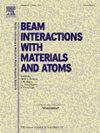Alpha particle thermoluminescence in LiF:Mg,Ti in the framework of conduction band/valence band dynamics
IF 1.4
3区 物理与天体物理
Q3 INSTRUMENTS & INSTRUMENTATION
Nuclear Instruments & Methods in Physics Research Section B-beam Interactions With Materials and Atoms
Pub Date : 2025-05-01
DOI:10.1016/j.nimb.2025.165711
引用次数: 0
Abstract
Kinetic models of thermoluminescence (TL) glow curves and dose response are based on the assumption that electrons and holes released from trapping centers during heating are thermally elevated to the conduction band (CB) and valence band (VB) where they are completely delocalized. The implication is that during heating the released charge carriers can recombine with the entire population of charges of the opposite sign. In the experiments described herein the CB/VB delocalization of the charge carriers preceding recombination is investigated by alpha particle irradiation of 0.1 mm and 0.9 mm samples of LiF:Mg,Ti (TLD-100). Following irradiation some trapped electrons escape from the alpha particle tracks during readout. Since the Bragg peak occurs at a depth of ∼104 Å, the alpha particle track serves as a source of low energy electrons limited to this depth of penetration. The sum of the two glow curves following irradiation on opposite sides of the sample is compared with the single glow curve obtained following irradiation on both sides. In the latter geometry, the electrons escaping the tracks, if delocalized, will be able to recombine with the charge carrier distribution on the opposite side of the sample, thereby altering the intensity and shape of the TL glow curve. The results do not reveal evidence for such behaviour and are in conflict with kinetic models involving CB/VB delocalization preceding recombination.
导带/价带动力学框架下LiF:Mg,Ti中的α粒子热释光
热释光(TL)发光曲线和剂量响应的动力学模型是基于在加热过程中从俘获中心释放的电子和空穴被热提升到完全离域的导带和价带的假设。这意味着,在加热过程中,释放的载流子可以与相反符号的整个电荷群重新结合。通过α粒子辐照0.1 mm和0.9 mm的LiF:Mg,Ti (TLD-100)样品,研究了复合前载流子的CB/VB离域。辐照后,在读出过程中,一些被捕获的电子从α粒子轨迹中逸出。由于布拉格峰发生在~ 104 Å的深度,α粒子轨迹作为低能电子的来源,限制在这个穿透深度。将样品两侧辐照后的两次辉光曲线之和与两侧辐照后的单次辉光曲线进行比较。在后一种几何结构中,逃离轨迹的电子如果离域,将能够与样品另一侧的载流子分布重新结合,从而改变TL发光曲线的强度和形状。结果没有揭示这种行为的证据,并且与重组前涉及CB/VB离域的动力学模型相冲突。
本文章由计算机程序翻译,如有差异,请以英文原文为准。
求助全文
约1分钟内获得全文
求助全文
来源期刊
CiteScore
2.80
自引率
7.70%
发文量
231
审稿时长
1.9 months
期刊介绍:
Section B of Nuclear Instruments and Methods in Physics Research covers all aspects of the interaction of energetic beams with atoms, molecules and aggregate forms of matter. This includes ion beam analysis and ion beam modification of materials as well as basic data of importance for these studies. Topics of general interest include: atomic collisions in solids, particle channelling, all aspects of collision cascades, the modification of materials by energetic beams, ion implantation, irradiation - induced changes in materials, the physics and chemistry of beam interactions and the analysis of materials by all forms of energetic radiation. Modification by ion, laser and electron beams for the study of electronic materials, metals, ceramics, insulators, polymers and other important and new materials systems are included. Related studies, such as the application of ion beam analysis to biological, archaeological and geological samples as well as applications to solve problems in planetary science are also welcome. Energetic beams of interest include atomic and molecular ions, neutrons, positrons and muons, plasmas directed at surfaces, electron and photon beams, including laser treated surfaces and studies of solids by photon radiation from rotating anodes, synchrotrons, etc. In addition, the interaction between various forms of radiation and radiation-induced deposition processes are relevant.

 求助内容:
求助内容: 应助结果提醒方式:
应助结果提醒方式:


